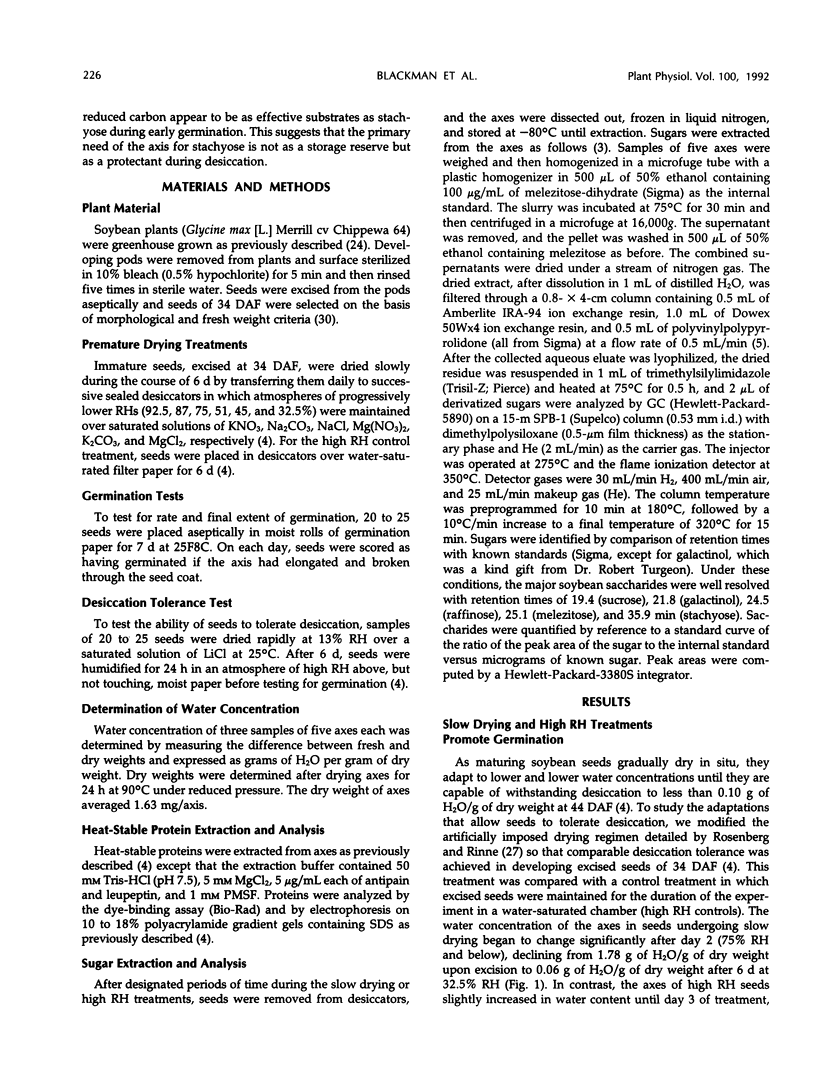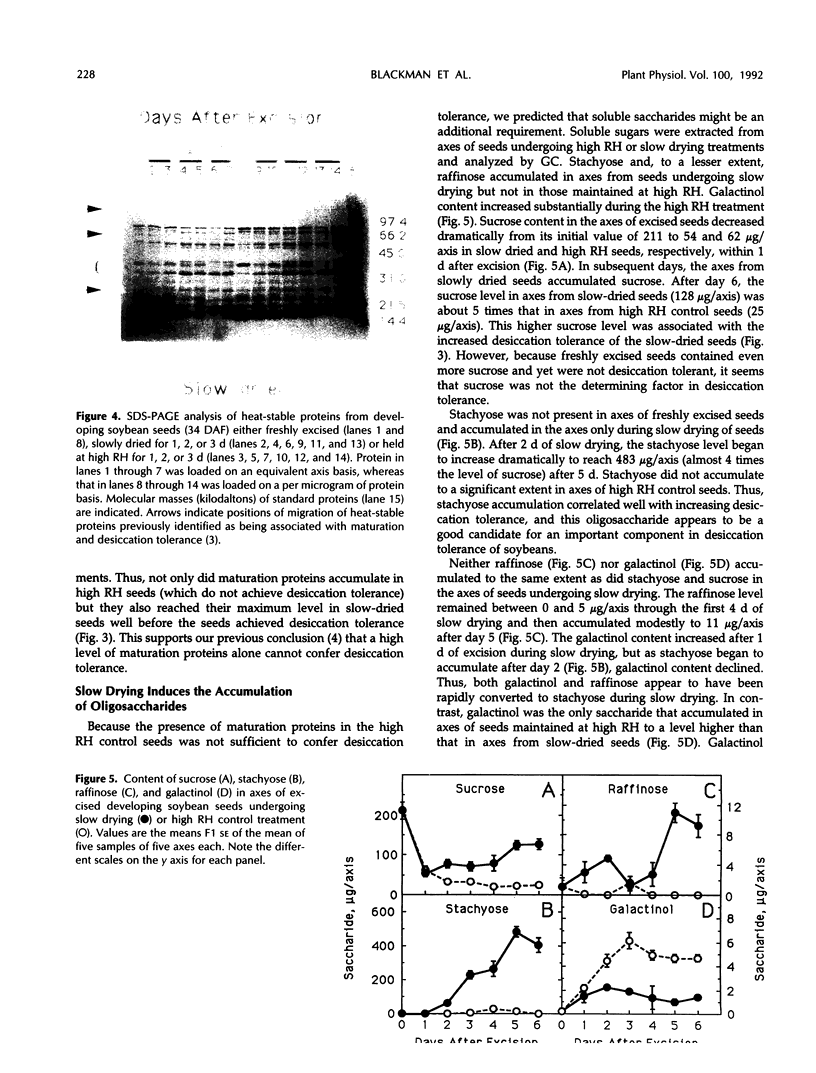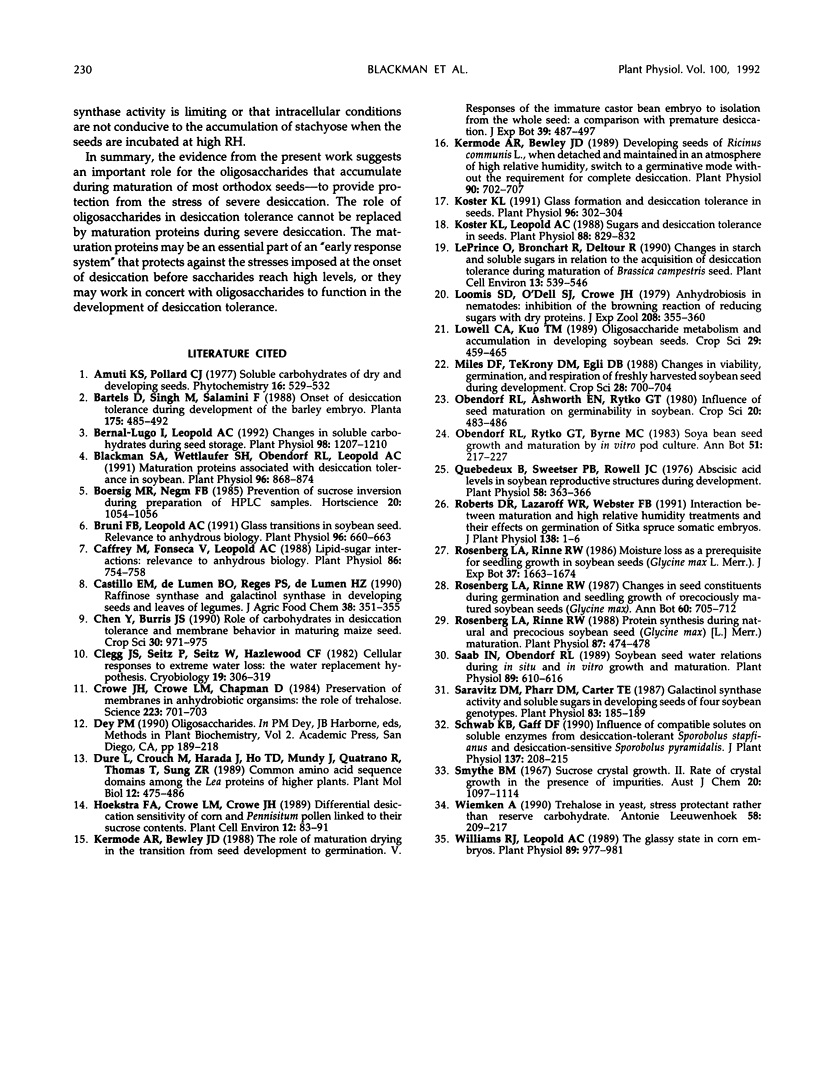Abstract
The desiccation-tolerant state in seeds is associated with high levels of certain sugars and maturation proteins. The aim of this work was to evaluate the contributions of these components to desiccation tolerance in soybean (Glycine max [L.] Merrill cv Chippewa 64). When axes of immature seeds (34 d after flowering) were excised and gradually dried (6 d), desiccation tolerance was induced. By contrast, seeds held at high relative humidity for the same period were destroyed by desiccation. Maturation proteins rapidly accumulated in the axes whether the seeds were slowly dried or maintained at high relative humidity. During slow drying, sucrose content increased to five times the level present in the axes of seeds held at high relative humidity (128 versus 25 μg/axis, respectively). Stachyose content increased dramatically from barely detectable levels upon excision to 483 μg/axis during slow drying but did not increase significantly when seeds were incubated at high relative humidity. Galactinol was the only saccharide that accumulated to higher levels in axes from seeds incubated at high relative humidity relative to axes from seeds that were slowly dried. This suggests that slow drying serves to induce the accumulation of the raffinose series sugars at a point after galactinol biosynthesis. We conclude that stachyose plays an important role in conferring desiccation tolerance.
Full text
PDF





Images in this article
Selected References
These references are in PubMed. This may not be the complete list of references from this article.
- Bernal-Lugo I., Leopold A. C. Changes in Soluble Carbohydrates during Seed Storage. Plant Physiol. 1992 Mar;98(3):1207–1210. doi: 10.1104/pp.98.3.1207. [DOI] [PMC free article] [PubMed] [Google Scholar]
- Blackman S. A., Wettlaufer S. H., Obendorf R. L., Leopold A. C. Maturation proteins associated with desiccation tolerance in soybean. Plant Physiol. 1991 Jul;96(3):868–874. doi: 10.1104/pp.96.3.868. [DOI] [PMC free article] [PubMed] [Google Scholar]
- Bruni F., Leopold A. C. Glass transitions in soybean seed : relevance to anhydrous biology. Plant Physiol. 1991 Jun;96(2):660–663. doi: 10.1104/pp.96.2.660. [DOI] [PMC free article] [PubMed] [Google Scholar]
- Caffrey M., Fonseca V., Leopold A. C. Lipid-sugar interactions : relevance to anhydrous biology. Plant Physiol. 1988 Mar;86(3):754–758. doi: 10.1104/pp.86.3.754. [DOI] [PMC free article] [PubMed] [Google Scholar]
- Clegg J. S., Seitz P., Seitz W., Hazlewood C. F. Cellular responses to extreme water loss: the water-replacement hypothesis. Cryobiology. 1982 Jun;19(3):306–316. doi: 10.1016/0011-2240(82)90159-6. [DOI] [PubMed] [Google Scholar]
- Crowe J. H., Crowe L. M., Chapman D. Preservation of membranes in anhydrobiotic organisms: the role of trehalose. Science. 1984 Feb 17;223(4637):701–703. doi: 10.1126/science.223.4637.701. [DOI] [PubMed] [Google Scholar]
- Kermode A. R., Bewley J. D. Developing Seeds of Ricinus communis L., When Detached and Maintained in an Atmosphere of High Relative Humidity, Switch to a Germinative Mode without the Requirement for Complete Desiccation. Plant Physiol. 1989 Jun;90(2):702–707. doi: 10.1104/pp.90.2.702. [DOI] [PMC free article] [PubMed] [Google Scholar]
- Koster K. L. Glass formation and desiccation tolerance in seeds. Plant Physiol. 1991 May;96(1):302–304. doi: 10.1104/pp.96.1.302. [DOI] [PMC free article] [PubMed] [Google Scholar]
- Koster K. L., Leopold A. C. Sugars and desiccation tolerance in seeds. Plant Physiol. 1988 Nov;88(3):829–832. doi: 10.1104/pp.88.3.829. [DOI] [PMC free article] [PubMed] [Google Scholar]
- Quebedeaux B., Sweetser P. B., Rowell J. C. Abscisic Acid Levels in Soybean Reproductive Structures during Development. Plant Physiol. 1976 Sep;58(3):363–366. doi: 10.1104/pp.58.3.363. [DOI] [PMC free article] [PubMed] [Google Scholar]
- Rosenberg L. A., Rinne R. W. Protein Synthesis during Natural and Precocious Soybean Seed (Glycine max [L.] Merr.) Maturation. Plant Physiol. 1988 Jun;87(2):474–478. doi: 10.1104/pp.87.2.474. [DOI] [PMC free article] [PubMed] [Google Scholar]
- Saab I. N., Obendorf R. L. Soybean Seed Water Relations during in Situ and in Vitro Growth and Maturation. Plant Physiol. 1989 Feb;89(2):610–616. doi: 10.1104/pp.89.2.610. [DOI] [PMC free article] [PubMed] [Google Scholar]
- Saravitz D. M., Pharr D. M., Carter T. E. Galactinol synthase activity and soluble sugars in developing seeds of four soybean genotypes. Plant Physiol. 1987 Jan;83(1):185–189. doi: 10.1104/pp.83.1.185. [DOI] [PMC free article] [PubMed] [Google Scholar]
- Wiemken A. Trehalose in yeast, stress protectant rather than reserve carbohydrate. Antonie Van Leeuwenhoek. 1990 Oct;58(3):209–217. doi: 10.1007/BF00548935. [DOI] [PubMed] [Google Scholar]
- Williams R. J., Leopold A. C. The glassy state in corn embryos. Plant Physiol. 1989 Mar;89(3):977–981. doi: 10.1104/pp.89.3.977. [DOI] [PMC free article] [PubMed] [Google Scholar]



